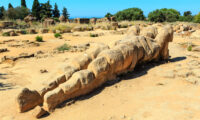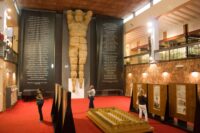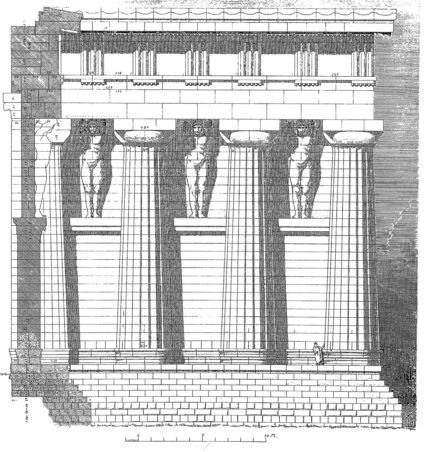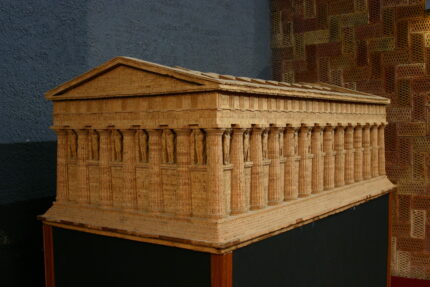 A colossal statue of Atlas that was toppled and buried centuries ago will stand again in front of the Temple of Zeus in Agrigento, Italy. The Titan was originally 26 feet high and was part of a group of about 40 that helped hold up the massive entablature of the Olympeion. It is now one of only two survivors. One of them has been recomposed and installed in the Regional Archaeological Museum of Agrigento where it takes up two storeys and
A colossal statue of Atlas that was toppled and buried centuries ago will stand again in front of the Temple of Zeus in Agrigento, Italy. The Titan was originally 26 feet high and was part of a group of about 40 that helped hold up the massive entablature of the Olympeion. It is now one of only two survivors. One of them has been recomposed and installed in the Regional Archaeological Museum of Agrigento where it takes up two storeys and  makes people look like ants. The second is on the dusty ground next to the remains of the temple.
makes people look like ants. The second is on the dusty ground next to the remains of the temple.
“The reinstalment of the statue of Atlas is the culmination of a more comprehensive restoration [of the temple],” says Roberto Sciarratta, director of the archaeological park.
“In the last decade, we’ve recovered and catalogued numerous artefacts that were once a part of the original structure … The goal is to recompose piece-by-piece the [entablature] of the Temple of Zeus to restore a portion of its original splendour.”
The Temple of Olympian Zeus was built around 480 B.C. to celebrate the Sicilian Greek colonies’ defeat of Carthage. Diodorus Siculus, writing more than 400 years after the events, said that after the Battle of Himera Agrigento “was crammed full of the captured” Carthaginians, so many that there were 500 prisoners of war for every Agrigentan. This vast new slave labor force was made to quarry stone and build ambitious public works — temples, large underground water conduits, a fish pool 4200 feet in circumference (that’s 8/10th of a mile) and 30 feet deep.
The Temple of Zeus was the most ambitious of them all. Even though its roof was never completed, the building was the largest Doric temple ever constructed. All this massiveness was constructed out of small sandstone blocks which makes it difficult for archaeologists to confirm its proportions and exact dimensions, as does the combined ruination wreaked by Carthage, natural disasters and mining of the remains for construction materials.
Here’s Diodorus’ detailed description of it, complete with awe-inspiring measurements:
The temple has a length of three hundred and forty feet, a width of sixty, and a height of one hundred and twenty not including the foundation. And being as it is the largest temple in Sicily, it may not unreasonably be compared, so far as magnitude of its substructure is concerned, with the temples outside of Sicily; for even though, as it turned out, the design could not be carried out, the scale of the undertaking at any rate is clear. And though all other men build their temples either with walls forming the sides or with rows of columns, thrown enclosing their sanctuaries, this temple combines both these plans; for the columns were built in with the walls, the part extending outside the temple being rounded and that within square; and the circumference of the outer part of the column which extends from the wall is twenty feet and the body of a man may be contained in the fluting, while that of the inner part is twelve feet. The porticoes were of enormous size and height, and in the east pediment they portrayed The Battle between the Gods and the Giants which excelled in size and beauty, and in the west The Capture of Troy, in which each one of the heroes may be seen portrayed in a manner appropriate to his role.
The Atlases alternated with the columns. They stood on platforms a little more than halfway up the walls of the temple. Here’s a rendering of the side of the temple from Die griechischen Tempel in Unteritalien und Sicilien by Robert Koldewey and Otto Puchstein (1899):
Here’s a model of the Temple of Zeus as it was in its heyday on display at the Regional Archaeological Museum:
Very little remains of the temple today — a few short walls, scattered blocks of stone, a couple of dramatically huge column capitals. I’m curious to see how they rig our Atlas friend to stand without a wall to mount it on like they have in the museum.


They still look like people.
The statue looks like rocks.
I don’t know. I think the recumbent statue should remain as is, with the additions of a pina colada and a beach umbrella.
Maud Karlsdottir is so right.
The survivors are 4. Only one almost complete, recomposed and installed in the museum. Of the further 3, only heads and little more fragments survive (in the museum too). No survivor is on the dusty ground next to the remains of the temple. That dusty one is simply a modern copy of the first one, made for tourists.
Hello, I am a Brazilian journalist and I’ve read a lot of different things about the statue. The Guardin article is very incomplete. The image in the museum is the same as the one that will be in front of the temple? Can somebody help me with credible information?
Hello, I am a Brazilian journalist and I’ve read a lot of different things about the statue. The Guardin article is very incomplete. The image in the museum is the same as the one that will be in front of the temple? Can somebody help me with credible information?
My email is szabatura@gmail.com